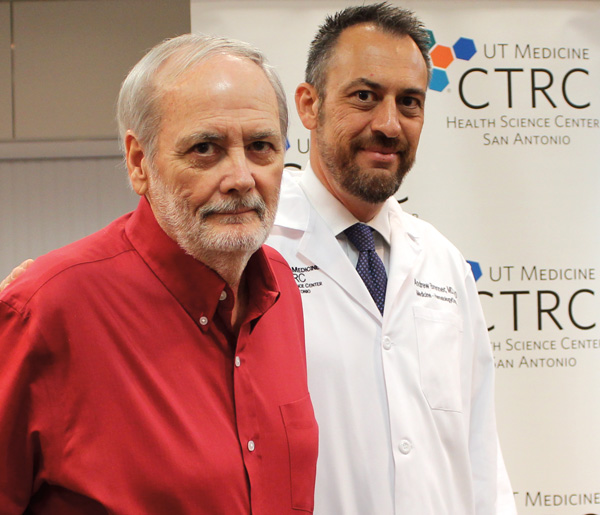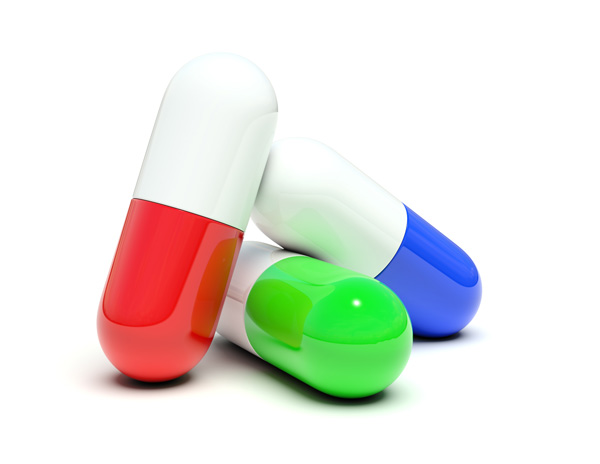Survival doubled

An experimental gene therapy nearly doubled the overall survival of patients with a recurrence of one of the deadliest and most aggressive brain cancers, glioblastoma.
Glioblastoma kills two-thirds of patients within five years; a patient’s outlook with recurrence of the disease is considered to be weeks or months.
A Phase 2 clinical research study evaluated the gene therapy, called VB-111, in continuous and intermittent doses and in comparison to the standard treatment, the chemotherapy Avastin. Patients receiving VB-111 survived 15 months on average, compared to an average of eight months for patients receiving Avastin alone.
“In addition to the benefit in overall survival, VB-111 was safe and well-tolerated in the patients, and proved to be effective both as a single therapy for recurrent glioblastoma and in combination with Avastin,” said Andrew J. Brenner, M.D., Ph.D., a medical oncologist with the Cancer Therapy & Research Center and associate professor in medicine, neurology and neurosurgery.
The CTRC and three other centers enrolled 62 patients with recurrent glioblastoma for the studies.
The gene therapy effectively starves the tumor by blocking its ability to grow new blood vessels, said Dr. Brenner, principal investigator of the studies. Tumors themselves begin the process by secreting a factor that activates the VB-111 drug.
“This drug outsmarts the cancer,” he said.
The drug is administered intravenously once every two months. The most frequent side effect in the study was fever, lasting one to two days following the infusion. This suggests an immune system response to the drug, which may play a role in its effectiveness, Dr. Brenner said.
Quitting smoking? We’ll text you.
All it takes is a simple text, “iquit,” to kick the habit.
Quitxt, a free text message and online support service, helps people beat smoking by sending them interactive messages, real-time support, hip-hop music, videos and other educational content. It is designed to help with motivation to quit, setting a quit date, handling stress and more.
The service is geared toward Latino young adults in South Texas. It was launched Oct. 13 by the Health Science Center with $1.4 million from the Cancer Prevention and Research Institute of Texas and the endorsement of the San Antonio Scorpions soccer team, SA2020 and other businesses and health groups.
“We developed Quitxt specifically for young adult Latino smokers to capitalize on their heavy usage of texting to help them quit,” said Amelie G. Ramirez, Dr.P.H., study leader and director of the Health Science Center’s Institute for Health Promotion Research. Her team worked with text message system expert David Akopian, Ph.D., from The University of Texas at San Antonio, to create the service.
Tobacco kills about 3,000 people in South Texas every year. Smoking rates are especially high among Mexican-Americans along the border and across South Texas, heightening the risk of cancer and heart disease.
Text message applications, as well as telephone and online counseling, have been shown to roughly double successful quit rates among smokers, with more impact in younger age groups.
Quitxt accepts smokers aged 18 and older. To join, text “iquit” to 57682.
By a thread

While silkworms have long been known to produce silk for fabric, researchers have discovered they also produce the perfect framework to grow stem cells into salivary gland cells.
This finding could play a critical role in providing relief for millions of people with dry mouth, a devastating oral and systemic health concern.
A research team led by Chih-Ko Yeh, B.D.S., Ph.D., a professor in the Department of Comprehensive Dentistry, is the first to use the fibers for stem cell growth. The process has been submitted for a patent.
“Salivary gland stem cells are some of the most difficult cells to grow in culture and retain their function,” Dr. Yeh said. “Until now, retention of salivary gland cell properties has not been possible using other tissue culture techniques. This unique culture system has great potential for future salivary gland research and for the development of new cell-based therapeutics.”
Saliva is critical to good health. It helps with speaking, swallowing, washing food off teeth, initial food digestion and preventing oral infections. Insufficient saliva can cause chronic bad breath, cavities, gum disease, as well as systemic infections.
There is no treatment for low-producing or nonfunctioning salivary glands, and the glands have little regenerative capability.
Silk is a good choice for stem cell scaffolding because it is natural, biodegradable, flexible and porous, providing the developing cells easy access to oxygen and nutrition. It also does not cause inflammation, as other scaffold materials have.
This is the first major step toward helping the more than 4 million people in the U.S. who have Sjögren’s syndrome, a degenerative autoimmune disease in which the body attacks its own tear ducts and salivary glands. Low saliva production also affects thousands of patients who have had radiation treatment for head and neck cancer, as well as about 50 percent of older Americans whose medications can cause dry mouth, also known as xerostomia.
Dr. Yeh hopes that within the next decade stem cells can be transfused into damaged human salivary glands to jump-start tissue repair or can be engineered into artificial salivary gland tissue to replace damaged glands.
Cure in sight for Hep C patients
 The outlook for the sickest hepatitis C patients—those with advanced cirrhosis or those who have had a liver transplant but the virus has returned—has historically been bleak.
The outlook for the sickest hepatitis C patients—those with advanced cirrhosis or those who have had a liver transplant but the virus has returned—has historically been bleak.
But researchers say that could change now that the U.S. Food and Drug Administration has cleared the way for expedited drug development and review of an investigational combination of drugs that shows promise for healing these patients.
The FDA has granted amended Breakthrough Therapy Designation for an oral regimen of daclatasvir and sofosbuvir taken with ribavirin for the treatment of patients with the genotype 1 strain of hepatitis C.
The decision was based on early results of the ALLY-1 clinical trial.
Fred Poordad, M.D., the principal investigator of the study, has been researching cures for hepatitis C for 20 years.
“We have had a lot of success recently with new oral medications for various groups of patients, but it’s exciting to see a cure in sight for patients who have the bleakest outlook,” said Dr. Poordad, clinical professor of medicine at the Health Science Center and vice president of academic and clinical affairs at the Texas Liver Institute. “We are refining treatments for different groups and I would say that in the next few years, we should be able to treat most genotypes very successfully.
“This is a very promising time for hepatitis C patients.”
The Phase III study evaluated a 12-week oral regimen of daclatasvir and sofosbuvir taken once a day with ribavirin. Results showed an overall cure rate of 94 percent for patients with a liver transplant and returning hepatitis C, and 83 percent for patients with advanced cirrhosis. The study’s primary endpoints also were reached, with 95 percent of post-transplant genotype 1 patients and 82 percent of genotype 1 patents with advanced cirrhosis being cured 12 weeks after treatment.
Earlier this year, the FDA had planned to withdraw the Breakthrough Therapy Designation for the regimen because of the availability of other medicines that were more successful for other genotypes. But based on the early data from the ALLY-1 trial, the FDA amended its original decision and opted to continue expedited development of this treatment for the subgroup of patients studied in ALLY-1.
The FDA is continuing its new drug application review of the daclatasvir-sofosbuvir regimen for the treatment of genotype 3 hepatitis C.
Don’t drink, ever, if pregnant
 Prenatal exposure to alcohol is the leading preventable cause of birth defects and intellectual and neurodevelopmental disabilities in children, according to a clinical report co-authored by Janet F. Williams, M.D., FAAP, professor of pediatrics in the School of Medicine.
Prenatal exposure to alcohol is the leading preventable cause of birth defects and intellectual and neurodevelopmental disabilities in children, according to a clinical report co-authored by Janet F. Williams, M.D., FAAP, professor of pediatrics in the School of Medicine.
No amount of alcohol should be considered safe to drink at any time during pregnancy, states the report from the American Academy of Pediatrics.
The range of effects that can occur in someone whose mother drank alcohol during pregnancy is called fetal alcohol spectrum disorders, and includes neurocognitive and behavioral problems. The effects of prenatal alcohol exposure are lifelong, but early recognition, diagnosis and therapy for any condition can improve a child’s health.
A lack of uniformly accepted diagnostic criteria for fetal alcohol-related disorders has critically limited efforts to lessen the impact of fetal alcohol spectrum disorders, said Dr. Williams.
“Even though fetal alcohol spectrum disorders are the most commonly identifiable causes of developmental delays and intellectual disabilities, they remain significantly under-recognized,” said Dr. Williams.
Prenatal alcohol exposure is a frequent cause of structural or functional effects on the brain, heart, bones and spine, kidneys, vision and hearing. It is associated with a higher incidence of attention deficit hyperactivity disorder and specific learning disabilities such as difficulties with math and language, visual-spatial functioning, impaired impulse control, information processing, memory skills, problem solving, abstract reasoning and auditory comprehension.
Even when a pregnant woman’s consumption was limited to one alcoholic drink per day—such as a 1.5-ounce shot of distilled liquor, 5 ounces of wine or 12 ounces of beer—there is increased risk of infant growth retardation, a recent study found. Yet 8 percent of women surveyed said they continued to drink during pregnancy.
Drinking during the first trimester, compared to no drinking, results in 12 times the odds of giving birth to a child with fetal alcohol spectrum disorders. First- and second-trimester drinking increased the odds 61 times, and women who drank during all trimesters increased the likelihood of fetal alcohol spectrum disorders odds by a factor of 65.
“The research suggests that the smartest choice for women who are pregnant is to just abstain from alcohol completely,” Dr. Williams said.
Chronic complication in diabetics explained
 Most patients with longstanding Type 1 diabetes have chronic gastrointestinal symptoms that significantly reduce their quality of life. And now researchers have a better understanding of why this happens.
Most patients with longstanding Type 1 diabetes have chronic gastrointestinal symptoms that significantly reduce their quality of life. And now researchers have a better understanding of why this happens.
These complications, called diabetic enteropathy, include the delayed emptying of food, irritable bowel syndrome, abdominal distension and fecal incontinence. The cause was previously unknown.
Intestinal tissues from diabetic patients and healthy people were compared in a study co-authored by Franco Folli, M.D., Ph.D., professor of medicine in the Diabetes Division of the School of Medicine. The studies were carried out by researchers at Boston Children’s Hospital and Harvard Medical School and San Raffaele Hospital in Milan, Italy, led by Paolo Fiorina, M.D., Ph.D.
“In patients with Type 1 diabetes, the cell lining of the intestine was damaged,” Dr. Folli said. “The stem cells that maintain this lining, called colonic stem cells, were altered. The culprit is found in a protein called insulin-like growth factor binding protein 3, which is produced in the liver and in higher amounts in Type 1 diabetes. It binds to a receptor protein on colonic stem cells, causing their death and, in turn, damaging the intestinal lining.”
The team also experimented with a biopharmaceutical that blocks circulating levels of the protein. Studies in diabetic mice show that the drug can reverse the colon damage.
“This has the potential to result in a new treatment for this chronic complication of longstanding Type 1 diabetes,” Dr. Folli said.
The findings were published in Cell Stem Cell.
Intolerant to chemicals? It could affect your children too.
Mothers with chemical intolerances are two to three times more likely than other women to have a child with autism spectrum disorder or attention deficit hyperactivity disorder, a new study shows.
The medical study, led by primary author Lynne P. Heilbrun, M.P.H., autism research coordinator for the Department of Family and Community Medicine, was published in The Journal of the American Board of Family Medicine.
People who are chemically intolerant often have serious reactions to common chemicals, and some become too sick carry out routine functions. Chemical intolerance affects about 10 to 30 percent of the U.S. population. Developmental disorders such as autism and attention deficit disorder affect 1 in 6 children in the United States.
The study was based on maternal responses to the Quick Environmental Exposure and Sensitivity Inventory, or QEESI, a 50-question survey used by physicians worldwide to diagnose chemical intolerance.
“We are most concerned about how vulnerable the children with ADHD and autism were to environmental exposures,” said Heilbrun. “Mothers reported that their children were significantly more sensitive to everyday exposures such as engine exhaust, gasoline, smoke, fragrances and cleaners than their neurotypical peers.”
The children reportedly also were more sensitive to adverse effects from infections, medications, chemicals, foods and allergens. They were more likely to have had nausea, headaches, dizziness or trouble breathing when exposed to smoke, nail polish remover, engine exhaust, gasoline, air fresheners or cleaning agents.
“Physicians have the opportunity right now to become proactive in helping mothers protect their children from neurological disorders plaguing U.S. families,” Heilbrun said, urging doctors to use QEESI to assess patients for potential chemical intolerances.
The authors also recommended all mothers and pregnant women avoid potentially harmful chemicals such as pesticides, solvents, combustion products, and chemicals used during construction and remodeling.
UT Dentistry has new home
 Its technology is considered ultra-modern. It is energy efficient. And within its 198,000 square feet, patients will receive the latest evidence-based care in a dozen specialties, and can be treated with anything from braces and dental implants to crowns and root canals.
Its technology is considered ultra-modern. It is energy efficient. And within its 198,000 square feet, patients will receive the latest evidence-based care in a dozen specialties, and can be treated with anything from braces and dental implants to crowns and root canals.
At a total cost of $96.5 million, the Center for Oral Health Care & Research officially opened its doors in September. Located at 8210 Floyd Curl, it sits across from the Medical Arts & Research Center and features 12 specialty clinics and 400 pre-doctoral and specialty operatories.
There is a dental surgery operating room and overnight recovery area built to hospital specifications, and extra-large monitors are prominent in all exam and surgical areas to offer patients and practitioners a better view of dental images. Dental chairs offer digital lighting and the most current examination equipment.
“The new Center for Oral Health Care & Research allows our faculty, residents and students to provide care in a technologically advanced setting that is second to none,” said William L. Henrich, M.D., MACP, president of the Health Science Center. “It enables our School of Dentistry to lead the way technologically and sustain our top-tier reputation in education, research and patient care.”
The first two floors are for faculty-led care of patients in various specialties of oral health. The third and fourth floors are used for general dentistry, including clinical training for third- and fourth-year dental and dental hygiene students who provide care to the public at a reduced rate.
School of Dentistry Dean William Dodge, D.D.S., said the new facility helps UT Dentistry fulfill its unique role as the academic dental practice for South Texas.
“This beautiful, energy efficient and technologically advanced clinic is only our second clinical home since the school began in 1970,” Dr. Dodge said. “What a step up.”
Growth spurt
 Regents approve millions in HSC construction
Regents approve millions in HSC construction
A new Health Science Center clinic will be constructed in north San Antonio.
The UT System Board of Regents in August approved $19.5 million for the construction of the multiservices center, which will be located on Interstate 10 West near Ralph Fair Road. It will expand teaching venues for students and trainees, enhance clinical research and make UT Medicine, the academic medical practice of the School of Medicine, available to more people.
The 18,000-square-foot facility will include exam rooms, conference rooms, offices for physicians, waiting rooms and a full-service imaging center with MRI, CT scan and general X-ray facilities.
“This clinic will be located in a high-growth area with a demonstrated need for both quality primary care and subspecialty medical services,” said William L. Henrich, M.D., MACP, president of the Health Science Center.
It is part of a clinical transformation plan that includes expanding and diversifying services of UT Medicine throughout San Antonio beyond the primary outpatient practice site, the Medical Arts & Research Center in the South Texas Medical Center. That facility is also slated to undergo a major clinical expansion this year.
The regents also approved $15 million to purchase and improve the Medical Centre Plaza building at 8431 Fredericksburg Road. The building will provide an additional 100,000 gross square feet of space to accommodate primarily administrative staff. The university had been leasing space in the building since 2006.
“The purchase will not only provide space for necessary expansion, but it will also generate cost savings of approximately $2 million a year,” Dr. Henrich said.
Tuition revenue bonds will be used to renovate other university buildings, many more than 40 years old. Updates will affect electrical, mechanical and plumbing systems, as well as security and safety, Dr. Henrich said.
Advanced degree now offered in respiratory care

Millions of Americans suffer from cardiopulmonary disease and need specialized care from a respiratory therapist.
The Health Science Center is meeting the need with a new master of science degree in respiratory care. The two-year program began this fall and is open to current respiratory therapists and students with no prior health care experience.
“More than 34 million people have asthma in the United States, approximately 13 million suffer from chronic obstructive pulmonary disease, or COPD, which is the third leading cause of death in America,” said David C. Shelledy, Ph.D., RRT, FAARC, dean of the School of Health Professions. “Because of underdiagnosis, we believe the actual number of those suffering from COPD is closer to 24 million.”
Respiratory care, also known as respiratory therapy, is the allied health profession that provides care to patients with cardiopulmonary disease. A respiratory therapist cares for patients of various ages, from newborns to the elderly. Common illnesses include asthma, emphysema, COPD, pneumonia, cystic fibrosis and respiratory distress syndrome.
The new degree was created because of the complexity of the care needed by these patients, Dr. Shelledy said.
“The master’s degree will prepare individuals to provide specialized care and to serve as the clinical leaders in the field, especially in the acute care setting in intensive care units,” he said.
It will be only one of four such degrees in the country.




